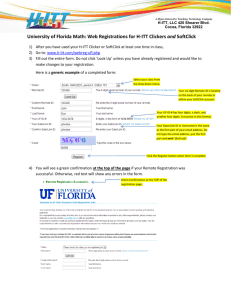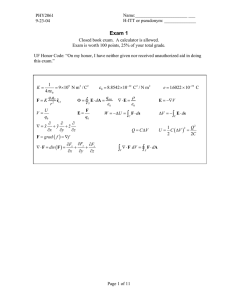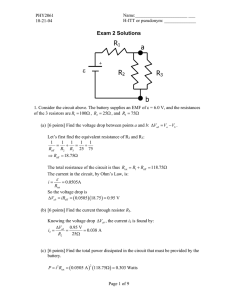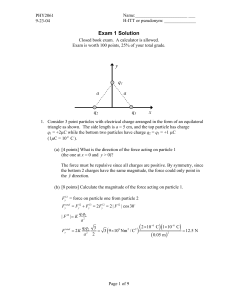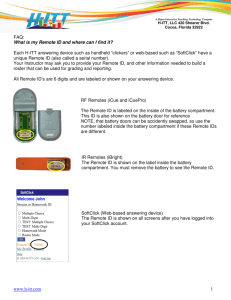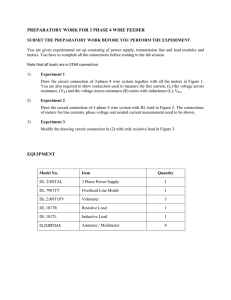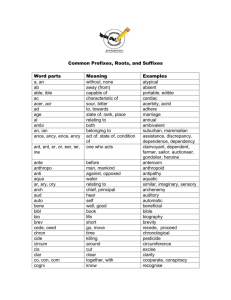Document 10437135
advertisement
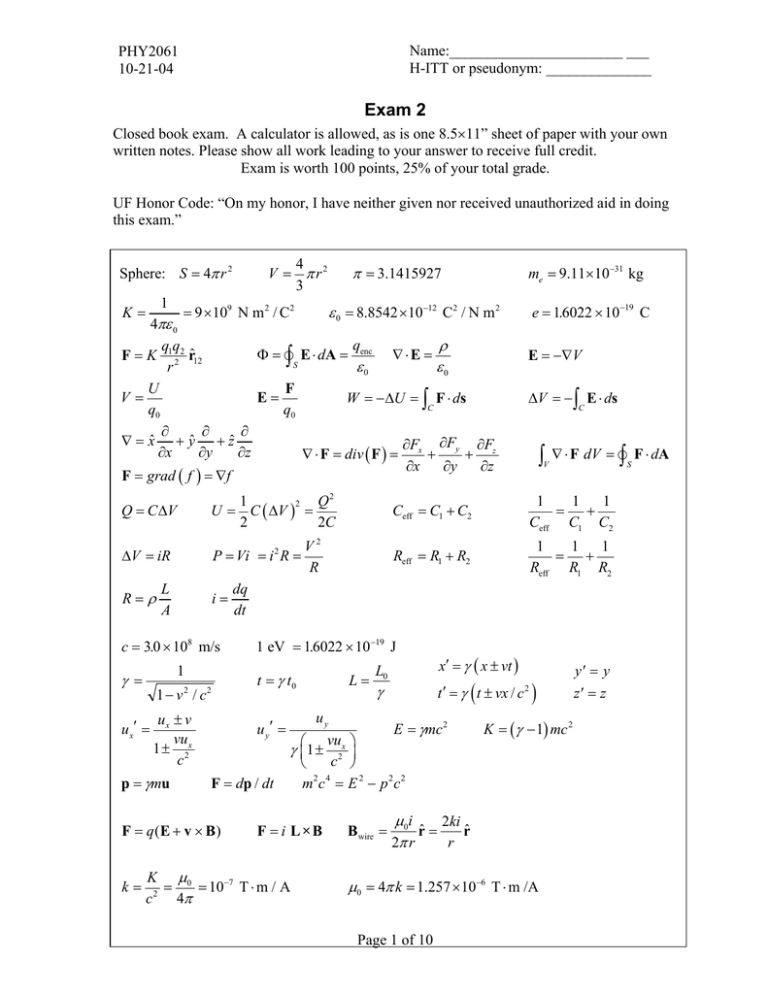
Name:_______________________ ___ H-ITT or pseudonym: ______________ PHY2061 10-21-04 Exam 2 Closed book exam. A calculator is allowed, as is one 8.5×11” sheet of paper with your own written notes. Please show all work leading to your answer to receive full credit. Exam is worth 100 points, 25% of your total grade. UF Honor Code: “On my honor, I have neither given nor received unauthorized aid in doing this exam.” 4 V = π r2 3 Sphere: S = 4π r 2 1 K= π = 3.1415927 me = 9.11×10−31 kg ε 0 = 8.8542 ×10−12 C2 / N m 2 = 9 ×109 N m 2 / C 2 4πε 0 q ρ qq Φ = v∫ Ε ⋅ dΑ = enc ∇ ⋅ E = F = K 1 2 2 rˆ12 S ε0 ε0 r U F V= E= W = −∆U = ∫ F ⋅ ds C q0 q0 ∂ ∂ ∂ ∇ = xˆ + yˆ + zˆ ∂F ∂Fy ∂Fz ∂x ∂y ∂z ∇ ⋅ F = div ( F ) = x + + ∂x ∂y ∂z F = grad ( f ) = ∇f Q = C ∆V 1 Q2 2 U = C ( ∆V ) = 2 2C ∆V = iR P = Vi = i 2 R = R=ρ L A i= c = 3.0 × 108 m/s 1 γ = 1 − v 2 / c2 u x′ = ux ± v vu 1 ± 2x c p = γmu k= E = −∇V ∆V = − ∫ E ⋅ d s C ∫ V ∇ ⋅ F dV = v∫ F ⋅ dΑ S Ceff = C1 + C2 1 1 1 = + Ceff C1 C2 Reff = R1 + R2 1 1 1 = + Reff R1 R2 dq dt 1 eV = 16022 . × 10−19 J t = γ t0 u y′ = F = dp / dt F = q (E + v × B ) V2 R e = 16022 . × 10−19 C L= L0 x′ = γ ( x ± vt ) t ′ = γ ( t ± vx / c γ uy E = γmc 2 ⎛ vu x ⎞ γ ⎜1 ± 2 ⎟ c ⎠ ⎝ 2 4 m c = E 2 − p2c2 F = i L×B K µ0 = = 10−7 T ⋅ m / A 2 c 4π B wire = 2 ) K = ( γ − 1) mc 2 µ0i 2ki rˆ = rˆ r 2π r µ0 = 4π k = 1.257 × 10−6 T ⋅ m /A Page 1 of 10 y′ = y z′ = z Name:_______________________ ___ H-ITT or pseudonym: ______________ PHY2061 10-21-04 R1 ε a + R2 R3 b 1. Consider the circuit above. The battery supplies an EMF of ε = 6.0 V, and the resistances of the 3 resistors are R1 = 100Ω , R2 = 25Ω , and R3 = 75Ω (a) [6 points] Find the voltage drop between points a and b: ∆Vab = Va − Vb . (b) [6 points] Find the current through resistor R2. Page 2 of 10 PHY2061 10-21-04 Name:_______________________ ___ H-ITT or pseudonym: ______________ (c) [6 points] Find the total power dissipated in the circuit that must be provided by the battery. (d) [8 points] Suppose an identical circuit (with the same resistors and battery configuration) is connected to the above circuit at points a and b. That is, a conductor connects point a of the first circuit to point a of the second circuit, and another conductor connects point b of the first circuit to point b of the second. Calculate the voltage drop between points a and b for this combined circuit. (Hint: apply Kirchoff’s laws to each loop of the circuit.) Page 3 of 10 Name:_______________________ ___ H-ITT or pseudonym: ______________ PHY2061 10-21-04 R1 a + ε C1 C2 S b 3. Consider the circuit above. A battery supplies an EMF of ε = 12.0 V, the resistance R1 = 1.25 MΩ , and the capacitors have capacitance C1 = 18µ F and C1 = 9µ F . Consider that switch S is closed at time t = 0. ( 1 MΩ = 106 Ω , 1µ F = 10-6 F ). (a) [6 points] What is the time constant of the circuit that governs how fast the current changes after the switch is closed ? (b) [6 points] What is the maximum charge attained on the top plate of capacitor C1 (i.e. at point a) after the switch is closed? Page 4 of 10 PHY2061 10-21-04 Name:_______________________ ___ H-ITT or pseudonym: ______________ (c) [6 points] Sketch the voltage drop ∆Vab = Va − Vb across the capacitors as a function of time t. Try to be accurate in your sketch. Page 5 of 10 PHY2061 10-21-04 Name:_______________________ ___ H-ITT or pseudonym: ______________ 3. A new type of cannon can launch 5 kg projectiles at the high velocity of 0.3c (a) [6 points] What is the minimum amount of energy required to accelerate a projectile from rest to this final velocity? (b) [6 points] If the cannon is mounted on the front of a spaceship traveling away from Earth at a velocity of 0.6c, what will be the velocity of the launched projectile in the reference frame of the Earth? Page 6 of 10 PHY2061 10-21-04 Name:_______________________ ___ H-ITT or pseudonym: ______________ 4. A kaon is an unstable particle with a rest mass energy of 500 MeV and an average lifetime of τ = 5.2 ×10−8 s in its rest frame. Consider a beam of kaons, where each kaon has a momentum of 1000 MeV/c as measured in a laboratory. (1 MeV = 1.6 ×10−13 J ) (a) [6 points] What is the velocity of each kaon in the laboratory? (b) [6 points] What is the average distance the kaons travel at this momentum in the laboratory before decaying? Page 7 of 10 PHY2061 10-21-04 Name:_______________________ ___ H-ITT or pseudonym: ______________ 5. A long straight wire has an electric charge density of λ = 7.0µ C / m along its length, where 1µ C = 10−6 C , as measured in the rest frame of the wire. (a) [6 points] What is the observed charge density of the wire as measured by an observer traveling at a velocity of v = 2.4 ×108 m/s parallel to the direction of the wire? (b) [6 points] What is the observed charge density of the wire as measured by an observer traveling at a velocity of v = 2.4 ×108 m/s perpendicular to the direction of the wire? Page 8 of 10 Name:_______________________ ___ H-ITT or pseudonym: ______________ PHY2061 10-21-04 y − − − − − − E x e- d + + + + + + + 6. [8 points] A beam of electrons (“cathode rays”) is sent between two parallel electric plates separated by a distance d = 1.5 cm with a potential difference of 300 V between them. The electric field points in the + yˆ direction. If the electron beam travels perpendicular to the electric field in the +xˆ direction, and each electron has a kinetic energy of 5,000 eV, what magnetic field is necessary (direction and magnitude) so that the electrons continue traveling in a straight line without deflection by the electric field? The charge of the electron is q = −e = −1.6 × 10−19 C , the electron rest-mass energy is 511,000 eV, and 1 eV = 1.6 ×10−19 J . Page 9 of 10 Name:_______________________ ___ H-ITT or pseudonym: ______________ PHY2061 10-21-04 iA d C iB 7. Consider two parallel wires, A and B, separated by a distance d = 0.5 cm as shown above. The current of wire A is iA = 9 A , and the current of wire B is iB = 3 A , both in the x̂ direction. (a) [6 points] Calculate the direction and magnitude of the magnetic field at point C, midway between the two wires in the plane of the wires. (b) [6 points] Find the direction and magnitude of the force per unit length (per meter) on wire B arising from the interaction of its current with the magnetic field of wire A. Page 10 of 10
